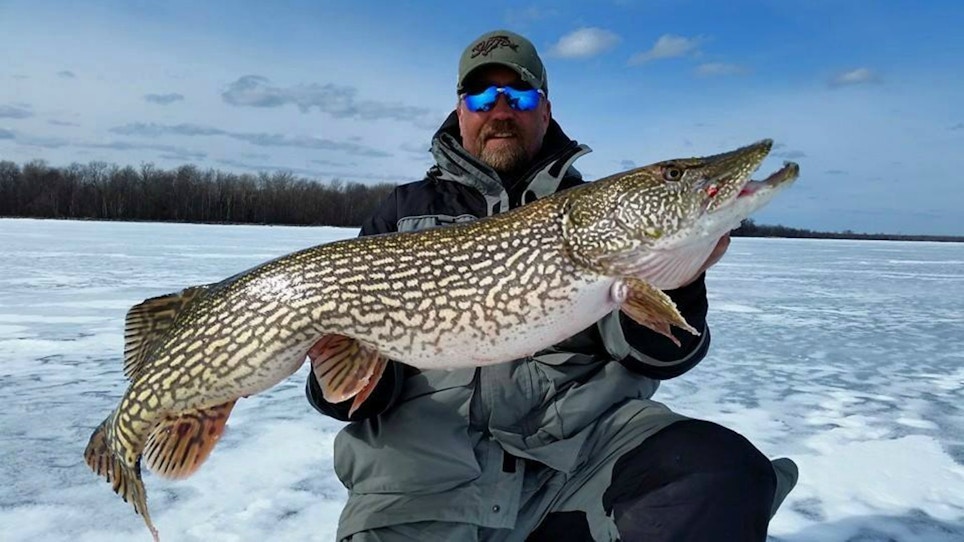If lakes don’t freeze where you live, chances are good you’ve never heard of tip-ups. Used exclusively by ice anglers, tip-ups are set lines that indicate a fish strike when a small, brightly colored flag suddenly flies vertical. These simple and affordable tools enable ice fishermen to strategically cover a piece of structure, regardless of depth.
In my home state of Minnesota, we can legally use two lines per angler during the ice fishing season. On a typical winter morning, my buddies and I will join forces to maximize our coverage below the ice. This tag-team effort means that if six of us are on the ice, we can set a dozen tip-ups. State law in Minnesota mandates that anglers must stay within 200 feet of a tip-up, so it’s common for our group to have our “flags” dotting an area that encompasses a football field — or more.
I’ll save more detailed tips and techniques for future follow-up articles, but my goal here is to simply get you started catching northern pike on tip-ups. Below, I’ll explain one specific situation where you can find success on your first ice fishing adventure this winter.
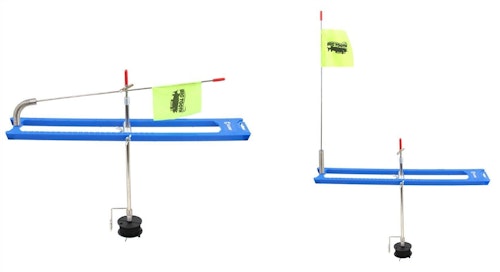
Where to Place Tip-Ups
My No. 1 location to target winter pike is a large bay. Ideally, the bay will feature a large weed flat, and the more green weeds present below the ice the better. While any weed type is good, the absolute best variety to find in the Midwest and North is cabbage. If I can find a large cabbage flat in 5-10 feet, I can almost guarantee that panfish will be present, and northern pike, which feed on sunfish, crappies and perch, will be there, too.
Assuming I’m with five buddies, so six anglers total, we’ll spread our dozen tip-ups in the following manner: four flags in 5-6 feet, four in 7-8 feet, and four in 9-10 feet. When we start drilling holes and setting tip-ups, we’ll space each of them 20-30 yards apart. The idea is to cover the weed flat as much as possible to find active northern pike. If we begin to see a pattern — example, the shallowest flags fly repeatedly but the deep ones don’t — then we’ll begin moving tip-ups. Generally, we’ll grab the tip-up located farthest from the action and drill a new hole 10 yards from a proven hotspot.
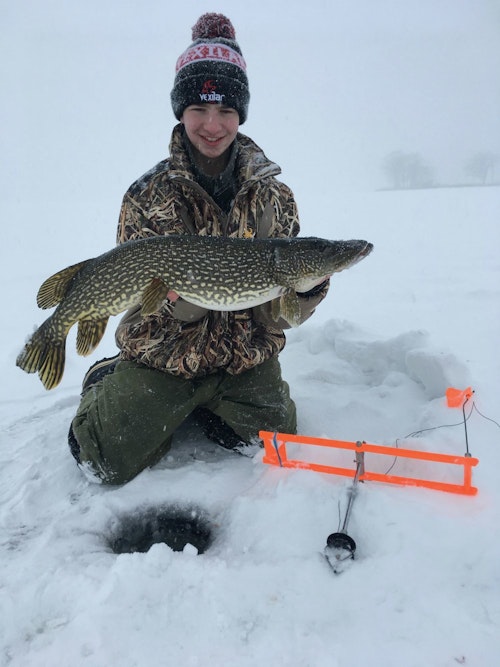
Choosing Bait
Because northern pike will strike either live bait or dead bait, you have some flexibility in this regard. Again, using a half-dozen anglers as an example, we’ll buy three dozen sucker minnows or shiners at the bait shop on the way to the lake. While the biggest pike often target the biggest minnows, when we desire the maximum amount of action, we usually buy medium-size minnows measuring 5-6 inches.
Do we go through 36 live minnows in a morning or afternoon of fishing? Not often. If we fish back-to-back days, we’ll use the living leftovers on day No. 2, but otherwise one of us will put the minnows in zipper bags and store them in the freezer. As I said earlier, dead bait is also attractive to pike. In fact, many anglers — me included — have found that large dead bait offerings such as 8- to 12-inch suckers are favorites of big pike.

How to Rig Minnows
With live minnows of 5-6 inches, I prefer a single treble hook. With longer minnows, I’ll go with a two-hook system. Either way, these systems are called “quick-strike rigs” because you don’t have to wait to set the hook after a strike. As soon as you get to the hole and the pike is swimming away at a steady pace, you simply grab the line in your hand and give it an upward tug. The small treble hooks are sharp and have no problem penetrating the hard mouth of a pike.
With a single treble system, place one hook from the treble through the skin of the sucker minnow’s back, near the dorsal fin. To keep the minnow lively below the ice, be careful to avoid hitting the minnow’s backbone/spine. The video at the bottom of this article demonstrates how to rig a two-hook system.
Several companies make high-quality quick-strike rigs; my favorite single-treble system is the Northland Tackle Single Wire Predator Rig; I like the version with size 4 treble. When I use live minnows or dead bait measuring 8-12 inches and a two-hook system is required, it’s tough to beat the Big Tooth Rig from Big Tooth Tackle Company; I like the version with size 2 trebles.
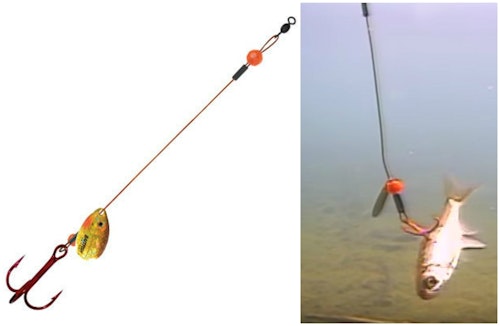
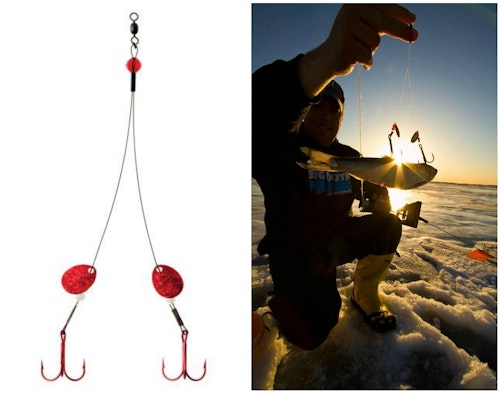
Setting Tip-Up Depth
I already talked about water depth for spreading the tip-ups (5-6 feet, 7-8 feet, etc.), but how far below the ice should you set your bait? Good question.
The answer really depends on weed growth; you don’t want your live minnow hiding on a weed stalk to avoid being eaten by a cruising pike. In general, if weeds grow up from the bottom 2 feet, then I’ll set the minnow a foot higher than the weed tops. However, at times the weeds are so thick and the depth so shallow that weeds almost reach the ice. In that case, it’s virtually impossible to keep a live minnow from wrapping in the weeds. The key in this situation is to find a pocket (hole) in the weeds. It might be the size of a dining room table. In any case, you want the live minnow to be vulnerable and easy to spot by a cruising pike. If the area is almost void of weeds, then I’ll place my minnow within a foot of the bottom.
Most tip-up anglers use a simple clip-on depthfinder weight that attaches just above the hook to determine depth. After you set the tip-up’s depth, you remove this clip-on weight and rig your minnow.
One tip: After you determine the correct depth, it’s a good idea to attach a small bobber to the line right next to the tip-up spool. That way, after a pike grabs your minnow and peels off a bunch of line, and after you land the fish, you can easily reset the tip-up by using the bobber/linemarker as a depth indicator.
Fill your tip-up spool with line specifically designed for tip-ups; it’ll be easier to handle in cold temps and won’t tangle as much as standard nylon or dacron line. Also, place a half-ounce egg sinker on the line before tying on the quick-strike rig. This added weight will keep your live minnow anchored below the hole. Note: When using dead bait that is thawed, you don’t need the added weight of the egg sinker. However, frozen dead bait floats, so it’s best to thaw it before fishing. Frozen dead bait also tends to break apart when you try to run hooks into it; thaw it first.
Two Critical Tools
Everyone in your tip-up fishing party should have two inexpensive tools with them at all times. The first is a long-nose pliers for removing hooks. Unlike a bass, pike have sharp teeth. Don’t reach into the mouth of a pike with your fingers!
The second tool is a jaw/mouth spreader. This clever accessory forces the mouth of a pike open so you can access a buried hook with your pliers.
Don’t be that guy (or girl) who shows up for a tip-up party without these tools. Even if you’re borrowing someone else’s tip-ups, the least you can do is carry your own pliers and mouth spreader. The tools are vital for open-water fishing, too, so chances are good that you already own them.
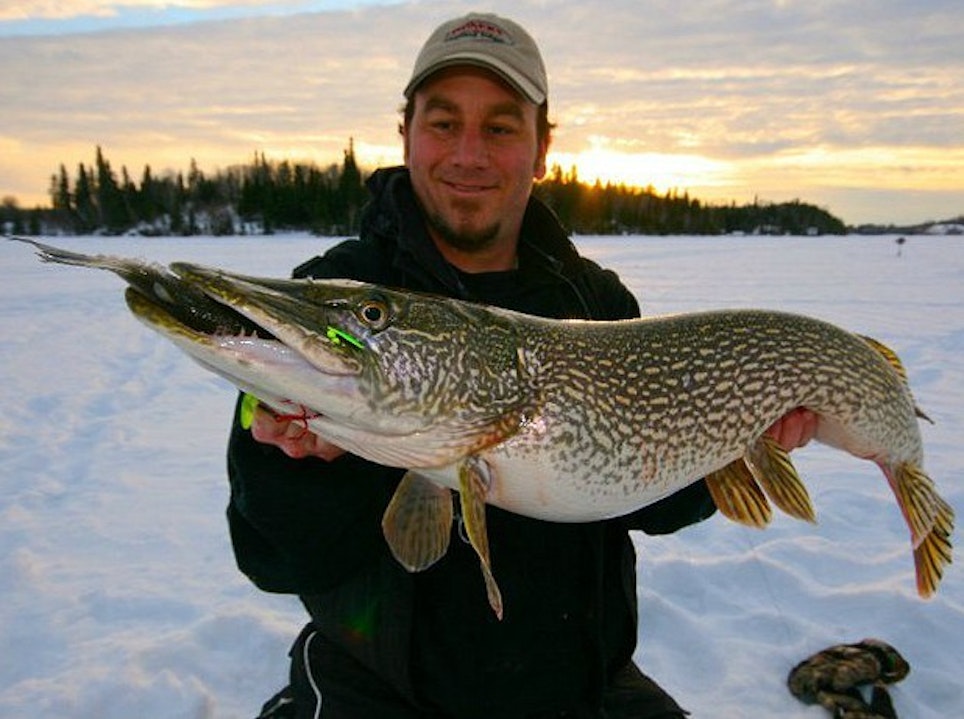
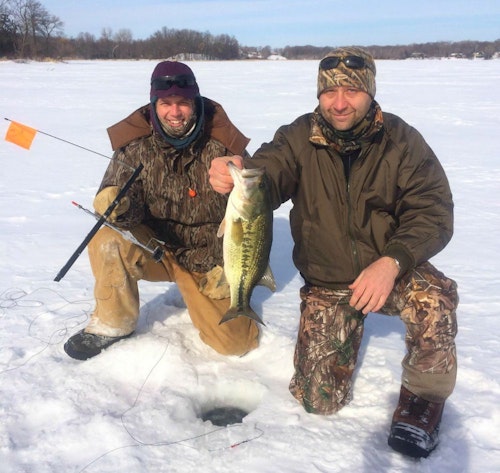
Check out the video below to see how to use a Big Tooth Rig for catching northern pike on tip-ups. As you can see, the two treble hooks go into a large minnow the same regardless of whether the bait is alive or dead.
Make plans to target northern pike this winter. The gear isn’t expensive, and it’s a blast yelling “tip up!” and then trying to outrun your buddy during a slippery sprint toward a waving flag.
